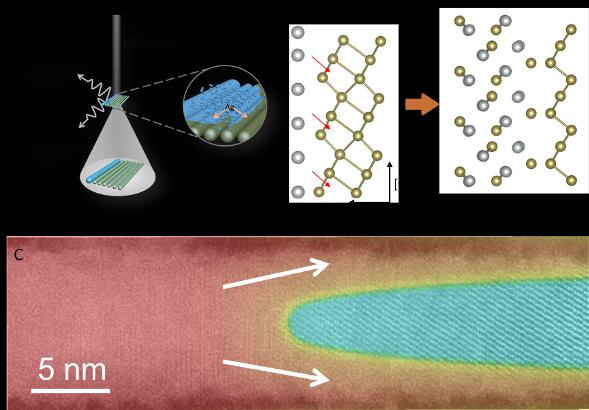Author:
University of Science and Technology of China
Date
05/06/2020

Image: A, Schematic illustration of the ion migration process under e-beam irradiation. B, Reconstructed atomic structure of proposed solid-phase migration within Te nanowire. C, Illustration of the migration path within Te nanowire.
The USTC team led by Prof. YU Shuhong from University of Science and Technology of China, collaborating with Prof. WU Jianbo from Shanghai Jiao Tong University, has shed new lights on the topic of solid-phase ion migration. Researchers demonstrated a unique in-situ strategy for visualizing the dynamic solid-phase ion migration between nanostructures with nanogap at the atomic scale. The research article entitled "Real-Time Visualization of Solid-Phase Ion Migration Kinetics on Nanowire Monolayer" was published in Journal of the American Chemical Society on April 29th.
Ion migration - the ion migrates through an intact anion sublattice or metal oxide lattice - has been recognized as a critical step in determining the performance of numerous devices in chemistry, biology, and material science. The reasonable control of ion transport process would significantly improve the corresponding properties. The Ion migration is usually accompanied with charge and mass transfer, which is complex and difficult to trace. To date, efforts have been devoted to investigating the dynamic migration mechanism, such as the external heating induced or electrically activated migration. However, direct visualization and quantitative investigation of ion migration in solid-phase remain a challenging task, which has been seldom reported. The requirements for specially designed apparatus also impede the comprehensive understanding of ion migration kinetics, which hamper further practical applications in various areas.
Chemical transmission electron microscopy (ChemTEM) is a newly emerging technique that allows the chemical reaction triggered by an electron beam during the imaging process. The kinetic energy and heat effect that transferred from the e-beam to samples are mainly responsible for the bond dissociation. By adjusting the e-beam dose rate, the type and rate of chemical reactions as well as the bond dissociation can be well controlled. This experimental approach offers an opportunity to investigate the in-situ ion migration process.
Taking up the challenge, the researchers report a unique technique to investigate the solid-phase ion migration process at the atomic scale using Ag ion on Te nanowires as the research model. This complicated process was tracked not only within a single nanowire but also between two neighboring nanowires with an obvious nanogap, which was revealed by both phase-field simulation and ab initio modeling theoretical evaluation. A migration "bridge" between neighboring NWs was observed. Furthermore, these new observations could also be applied to the migration of other noble metal ions on other semiconductor nanowires (Ag ion migration on Se@Te nanowires and migration of Cu ion on Te nanowires). These findings provide critical insights into the solid-phase ion migration kinetics occurring in nanoscale systems with generality and offer an efficient tool to explore other ion migration processes, which will facilitate the fabrication of customized and new hetero-nanostructures in the future.
EurekAlert!, the online, global news service operated by AAAS, the science society: https://www.eurekalert.org/pub_releases/2020-05/uosa-rvo050620.php